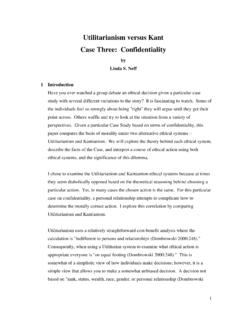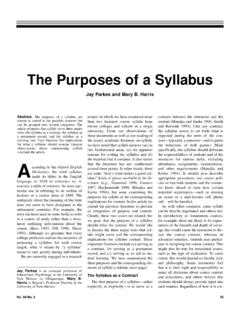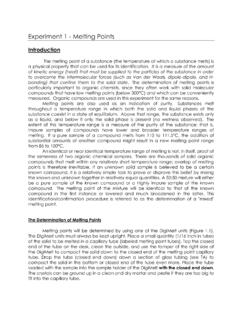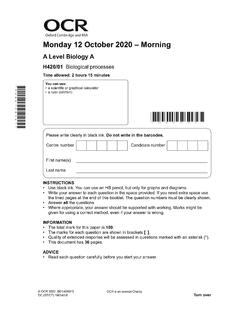Transcription of CALORIMETRY EXPERIMENT A ENTHALPY OF FORMATION …
1 A-1 Revised 6/2016 CALORIMETRY EXPERIMENT A ENTHALPY OF FORMATION OF MAGNESIUM OXIDE INTRODUCTION This EXPERIMENT has three primary objectives: 1. Find the heat capacity (Cp) of a calorimeter and contents (calibration). 2. Determine the Hrxn, the ENTHALPY of reaction, in kJ/mol for several different reactions, including the reaction of an unknown with a solution of HCl. 3. Calculate the Hf, the ENTHALPY of FORMATION , of MgO using Hess Law (in kJ/mol). We will assume that the energy exchanged between the calorimeter and the surroundings during and following the reactions is small and at a slow, constant rate. You will become familiar with CALORIMETRY concepts, computer data collection, and calculations.
2 BACKGROUND CALORIMETRY measures the energy that a reaction produces or consumes. For example, the major difference between gasoline grades is the octane number. Unleaded gas has an octane of 86, while Super Unleaded gas has a higher octane. CALORIMETRY could be used to measure the heat or energy produced when gasoline is burned. More heat (energy) would be produced by the super unleaded gas so it would have a higher ENTHALPY compared to just unleaded gas. CALORIMETRY could be used to see if a gasoline station is selling the grades of gasoline it advertises. The calories in food have also been measured by CALORIMETRY (hence the term calories). Usually this is a measurement of calories (cal) per gram of food.
3 Remember that calories are easily convertible to joules (J) and grams can be converted to moles if it is a pure chemical. ENTHALPY , represented by the symbol H, is a property chemists use to describe the heat flow into or out of a system in a constant-pressure process. This is often the case since most processes that are carried out are exposed to the atmosphere as are the reactions carried out in this course. The ENTHALPY of a reaction, Hrxn, is defined as the difference between the enthalpies of the products and the enthalpies of the reactants. In other words, it is the change in energy for a given amount of a given reaction. The ENTHALPY of FORMATION , Hf is defined as the ENTHALPY or heat change that results when one mole of a compound is formed from its elements.
4 The standard ENTHALPY of FORMATION is defined as the ENTHALPY of FORMATION measured at 1 atm such that the elements are in their standard state. If a reaction is exothermic, heat will be released, and the temperature of the system or reaction mixture will rise. (In this EXPERIMENT the heat and temperature rapidly increase and then slowly decrease as heat is lost to the surroundings.) For endothermic reactions heat will be absorbed or used and the temperature will decrease. In this EXPERIMENT we will use the experimentally measured ENTHALPY of reaction for a series of exothermic A-2 Revised 6/2016 reactions and Hess' Law to determine the heat of FORMATION for magnesium oxide (MgO).
5 We will also determine the ENTHALPY of reaction for an unknown metal oxide with an acid. For this EXPERIMENT pressure will be constant so ENTHALPY of Reaction and Heat of Reaction ( Hrxn) are assumed to be the same. The ENTHALPY of reaction, Hrxn, can be calculated using the equation: = ( )( ) = ( C)( C) = A-1 Where n is the moles of limiting reagent, T ( C) is the change in temperature in of the calorimeter s contents, and Cp (kJ/ C) is the heat capacity of the calorimeter. The value for n can be determined knowing the amounts of starting material. The T for a reaction can be calculated using the temperatures before and after the reaction or the initial and final temperatures.
6 The heat capacity, Cp, of the calorimeter has to be experimentally determined by doing a reaction where the Hrxn is known. The heat capacity of the calorimeter is primarily due to the solution in the cup. Heat capacity (Cp) has units of kJ/ C. Physically, this means that it takes the value of the Cp in energy to raise the calorimeter by 1 C. For example, if a calorimeter has a Cp of kJ/ C, the calorimeter, including its contents, must absorb kJ of energy to increase 1 C. A 20 kJ/ C calorimeter increases 1 C with one hundred times more energy, or 20 kJ. Cp varies depending on the substance or system and describes how much energy is needed to change the temperature of that substance or system.
7 The Cp of an ocean is huge (compared to a drop of water) such that the oceans of the world maintain the earth at temperatures that support life. In this EXPERIMENT , the calorimeter is defined as two nested styrofoam cups, the lid, magnetic stir bar, and the temperature probe tip, plus the mL of the reaction mixture (mainly water). In order for the heat capacity of the calorimeter to remain constant, all of these must be present. Figure A-1 Calorimeter Apparatus (ignore B-1) NOTE: If less than 60 mL of reaction mixture was added, it would take less energy to increase the calorimeter and contents by 1 C. In other words, the heat capacity would decrease. If more than 60 mL of the mixture was added, more energy would be needed to increase the calorimeter and contents by 1 C.
8 The heat capacity is then increasing. A-3 Revised 6/2016 Most importantly the volume of reaction mixture must remain constant because of the large heat capacity of water. We want the Cp to remain constant because it is the standard by which we can calculate unknown Hrxn values in reactions 1, 2, and 4. The Cp is determined in the reaction of HCl with NaOH, using the known ENTHALPY (energy/mole) for a strong acid/strong base reaction: H+ (aq) + OH- (aq) H2O (l); Hrxn = (molkJ) at 25 C A-2 Rearranging equation A-1 we can use this Hrxn to solve for Cp. = ( )( ) =( )( ) C= C A-3 A value for T in C can then be determined for a known amount of moles (n).
9 Once the Cp is known we can use it to calculate Hrxn for other reactions where T has been experimentally determined. Please look in your textbook under CALORIMETRY or thermodynamics for more information on these concepts. The explanation to determine T is in the experimental section below. EXPERIMENTAL This EXPERIMENT essentially has three parts. In the first lab period, the data to determine the ENTHALPY of reaction for Mg + HCl and MgO + HCl will be collected (one trial on each). During the second lab period, data will be collected to calculate the Cp using the reaction of NaOH with HCl (two trials). Also, the ENTHALPY of reaction for the Exp. An unknown reacting with HCl will be determined (two trials).
10 The trials for the Cp and unknown should be run in the same lab period. Be sure to label each graph carefully with your name, section, date, reaction & trial, mass of reactant, etc. Note that the Hrxn is not done until after Cp is determined the second week. Tape graphs into your notebook as you print them. EQUIPMENT AND MATERIALS: 1. Temperature probe connected to computer via analog to digital interface box 2. Vernier Data Logger software 3. Calorimeter (two nested styrofoam cups and lid labeled with your bin number) 4. Thermometer 5. Stirrer-hot plate and teflon stir bar 6. Spatula and electronic balance 7. 25 mL graduated cylinder (or 25 mL pump dispenser) 8. Various sizes of beakers and erlenmeyer flasks 9.













